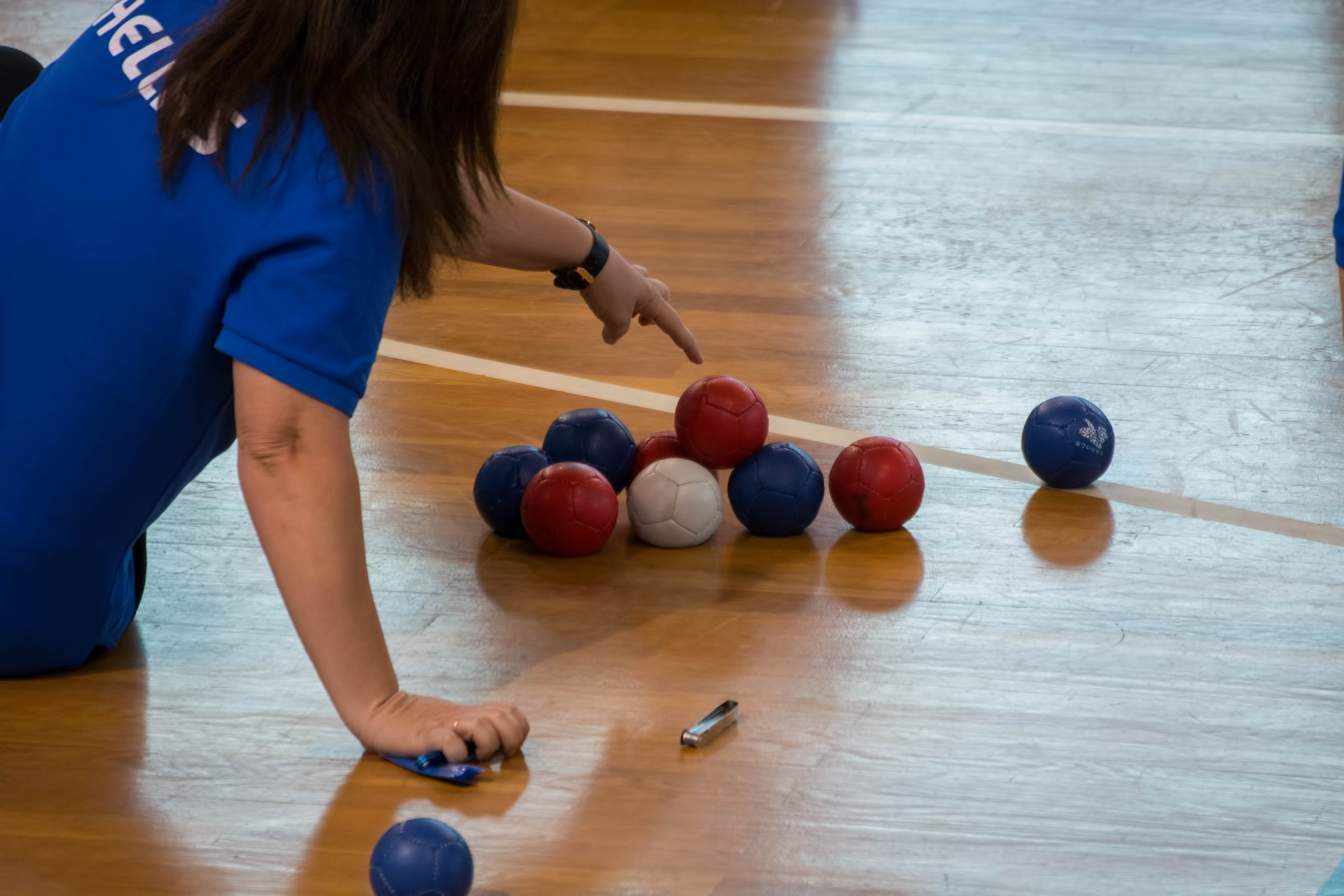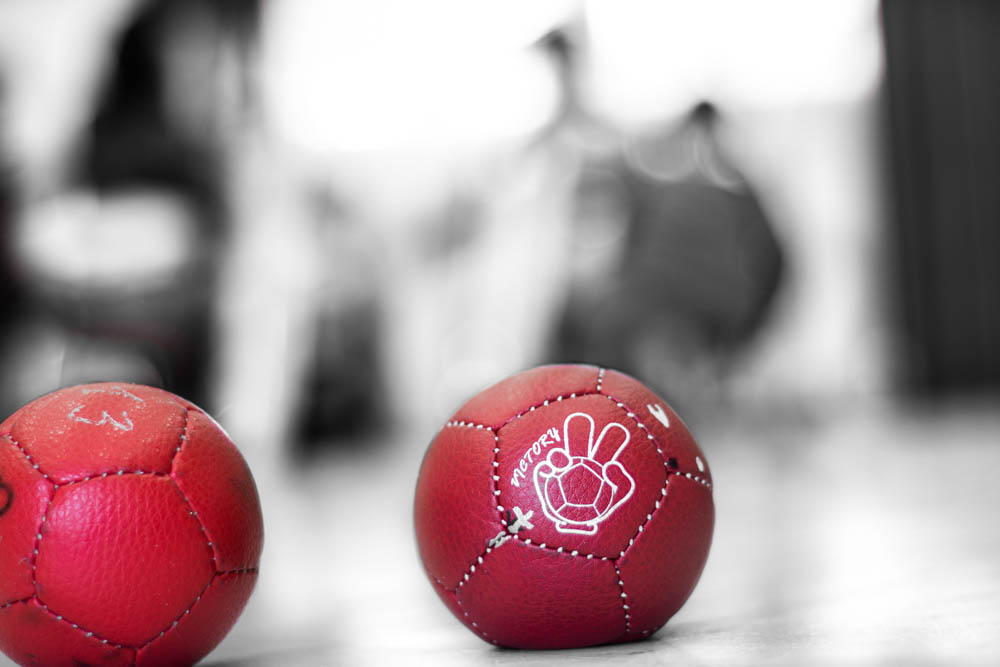BOCCIA
About the game
Boccia can be played by individuals, pairs, or teams of three. All events are mixed gender. The aim of the game is to throw leather balls — coloured red or blue (which side uses which is determined by a coin toss) as close as they can to a white target ball, or jack. The jack is thrown first, then the first two regular balls are played (first, the player who threw the jack then the opposing side), after which the side furthest away from the jack goes next in an attempt to either get closer to the jack or knock the opposition's ball out of the way. In this fashion, each end will continue until one side has played all their balls, at which point, the opposing side will play their remaining balls. The balls can be moved with hands, feet, or, if the competitor's disability is severe, with an assistive device such as a ramp. At the end of each round, or end, the referee measures the distance of the balls closest to the jack, and awards points accordingly — one point for each ball that is closer to the jack than the opponent's closest ball. The team/player with the highest number of points at the end of play is the winner. If both teams have the same number of points after all ends have been played, one additional end is played to determine a winner.

The number of ends and balls in each end depends on the side makeup. Individual competition consists of four ends and six balls per player per end, whilst paired competition is four ends and six balls per pair per end (three per player). Team competition is six ends, and six balls per team per end (two per player).
In pair and team events, a reserve player is allowed. Between ends a reserve can be substituted for a player during a game, but only one substitution per game is permitted.

Boccia is played on a court measuring 12.5 × 6 m with 2 m of empty space around it. The surface of the court is flat and smooth. The throwing area is divided into six rectangular throwing boxes in which the athletes must stay completely within during play. On the court is a V-shaped line over which the jack must cross for the throw to be valid. At the end of the court is the ‘dead ball container’ in which balls are put if they are thrown outside the time limit, out of the area of play or if the athlete violates a rule during his or her throw. A cross marks the position where the jack must be placed if it touches or crosses the boundary line or in the case of a tie-break. The balls themselves are made of leather and are slightly larger than a tennis ball, weighing approximately 275 grams and measuring 270 mm in circumference. They are available in different grades of softness and hardness.

Classification
To be eligible to compete in boccia at national or international level, athletes must have a disability and be in a wheelchair, as a result of cerebral palsy, or another neurological condition that has similar effects, such as muscular dystrophy or traumatic brain injury. Players are examined to determine the extent of their disability and then assigned to a sport class, designed to allow them to compete against other athletes with a similar level of physical function.
Boccia players are assigned to one of four sport classes, depending on their functional ability:
BC1 – Players in this class throw the ball with the hand or foot. They may compete with an assistant who stays outside the competitor's playing box, to stabilize or adjust their playing chair and give the ball to the player when requested.
BC2 – Players in this class throw the ball with the hand. They are not eligible for assistance.
BC3 – Players in this class have very severe locomotor dysfunction in all four extremities. Players in this class have no sustained grasp or release action and although they may have arm movement, they have insufficient range of movement to propel a boccia ball onto the court. They may use an assistive device such as a ramp to deliver the ball. They may compete with an assistant; assistants must keep their back to the court and their eyes averted from play.
BC4 – Players in this class have severe locomotor dysfunction of all four extremities as well as poor trunk control. They can demonstrate sufficient dexterity to throw the ball onto the court. Players are not eligible for assistance.

I've played Boccia before! A bunch of times actually, but it's been awhile. It's always a fun game to play when I get together with the family.
Downvoting a post can decrease pending rewards and make it less visible. Common reasons:
Submit
It's a great game.
Downvoting a post can decrease pending rewards and make it less visible. Common reasons:
Submit
Well done
Nice post !
Downvoting a post can decrease pending rewards and make it less visible. Common reasons:
Submit
Thank you very much.
Downvoting a post can decrease pending rewards and make it less visible. Common reasons:
Submit
Μπράβο!!!!!!! resteem
Downvoting a post can decrease pending rewards and make it less visible. Common reasons:
Submit
Ευχαριστώ πολύ!
Downvoting a post can decrease pending rewards and make it less visible. Common reasons:
Submit
Congratulations @otsouvalas! You have completed some achievement on Steemit and have been rewarded with new badge(s) :
Click on any badge to view your own Board of Honor on SteemitBoard.
For more information about SteemitBoard, click here
If you no longer want to receive notifications, reply to this comment with the word
STOPDownvoting a post can decrease pending rewards and make it less visible. Common reasons:
Submit
Excellent publication, you transmit a very accurate and updated information. Thank you very much.
Downvoting a post can decrease pending rewards and make it less visible. Common reasons:
Submit
I tried to publish a beautifull game with powerfull players. Thank you for your upvote
Downvoting a post can decrease pending rewards and make it less visible. Common reasons:
Submit
Thank you for writing about this sport. I enjoyed learning about Boccia.
Downvoting a post can decrease pending rewards and make it less visible. Common reasons:
Submit
I thank you for your upvote.
I will try to make more posts about boccia and will make a movie too
Downvoting a post can decrease pending rewards and make it less visible. Common reasons:
Submit
Nicely written! I had no idea about the rules of this game.
Downvoting a post can decrease pending rewards and make it less visible. Common reasons:
Submit
It is hard game :)
Downvoting a post can decrease pending rewards and make it less visible. Common reasons:
Submit
Very interesting! I'm a sports (& games in general) fan and I knew nothing of boccia before!
Downvoting a post can decrease pending rewards and make it less visible. Common reasons:
Submit